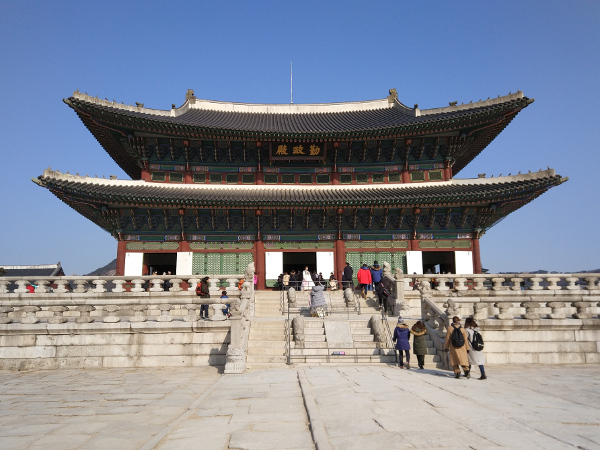Cours de coréen ᚛ Level 1 - My First Steps in Korean (Lessons 1 to 30) ᚛ Leçon 16 - Conjugations Exceptions in the Present Tense
Conjugations Exceptions in the Present Tense
We now know how to conjugate verbs in the present tense in Korean, and we have seen that in some cases it is necessary to use vowel contractions. Unfortunately, these are not the only conjugation exceptions in Korean. Indeed, it is important to pay attention to the verbs which have stems that end in a certain consonant or vowel. Moreover, there are exceptions to these exceptions! Some verbs, although they have a structure corresponding to an exception, are not affected. Only experience will tell you which verbs are regular and which are irregular. In the meantime, you can consult the list of irregular verbs in Korean.
Verbs in 하다
Verbs ending in -하다 as well as the verb 하다 (= to do) itself are all irregular.
The present form of the verb 하다 is 해 in the casual style and 해요 in the polite style.
The verb 공부하다 (= to study) ends in 하다, so its conjugation is irregular. In the present 공부하다 conjugates 공부해 in the casual style and 공부해요 in the polite style.
- 공부하다 → 공부해. = I am studying. / You study. / He studies… etc.
The verb 말하다 (= to speak) ends in 하다, so its conjugation is irregular. In the present 말하다 conjugates 말해 in the casual style and 말해요 in the polite style.
- 말하다 → 말해. = I speak. / You speak. / He speaks… etc.
The stem ends in ㅂ
For some verbs with a stem ending in ㅂ, the present tense conjugation is as follows:
Remove the final ㅂ from the stem and then add the syllable 워.
The irregular verb 춥다 (= to be cold) has the stem 춥 which ends in ㅂ. We first remove the final ㅂ from the stem, we then get 추. Then we add 워. So, 춥다 is conjugated as 추워 in the casual style and 추워요 in the polite style.
The irregular verb 덥다 (= to be hot) has a stem 덥 which ends in ㅂ. We first remove the final ㅂ from the stem, we then get 더. Then we add 워. So, 덥다 is conjugated as 더워 in the casual style and 더워요 in the polite style.
Be careful, the verbs 돕다 (= to help) and 곱다 (= to be pretty) have a particular conjugation. For these two verbs, we add the syllable 와 and not 워.
- 돕다 is conjugated as 도와 in the casual style and 도와요 in the polite style.
- 곱다 is conjugated as 고와 in the casual style and 고와요 in the polite style.
Note: Not all verbs with a stem ending in ㅂ are irregular. For more information, please consult the sheet on irregular verbs in Korean.
The stem ends in ㄷ
For some verbs with a stem ending in ㄷ, the present tense conjugation is as follows:
Replace the final ㄷ of the stem by ㄹ then add the ending following the normal conjugation rules (아 or 어).
The irregular verb 깨닫다 (= to become aware) has the stem 깨닫 which ends in ㄷ. We first replace the final ㄷ of the stem by ㄹ, we then get 깨달. Then, because the stem ends in a syllable containing the vowel ㅏ, we add 아. So, 깨닫다 is conjugated 깨달아 in the casual style and 깨달아요 in the polite style.
The irregular verb 듣다 (= to listen) has a stem 듣 which ends in ㄷ. We first replace the final ㄷ of the stem by ㄹ, we then get 들. Then, because the stem ends in a syllable that does not contain ㅏ or ㅗ, we add 어. So, 듣다 is conjugated as 들어 in the casual style and 들어요 in the polite style.
Note: Not all verbs with a stem ending in ㄷ are irregular. For more information, please consult the sheet on irregular verbs in Korean.
The stem ends in ㅅ
En savoir +
The stem ends in ㅎ
En savoir +
The stem ends in ㅡ
En savoir +
The stem ends in 르
En savoir +
Summary table of structure
En savoir +
Exercises
En savoir +
Retrouvez deux livres numériques imprimables contenant TOUT ce que vous devez savoir pour devenir un expert de la conjugaison coréenne. Toutes les formes verbales les plus utilisées en Corée, des explications sur les nombreuses exceptions de la conjugaison coréenne, le détail de conjugaison de 500 verbes et adjectifs courants et plus de 1000 phrases concernant des situations courantes afin de bien utiliser ces verbes. Un indispensable peu importe votre niveau en coréen !
En savoir +

